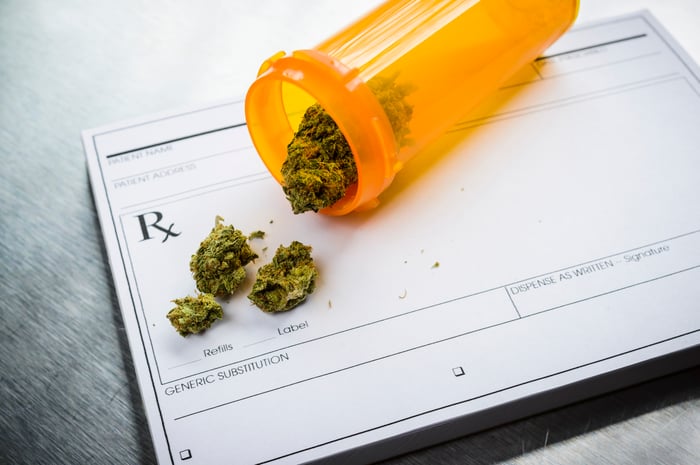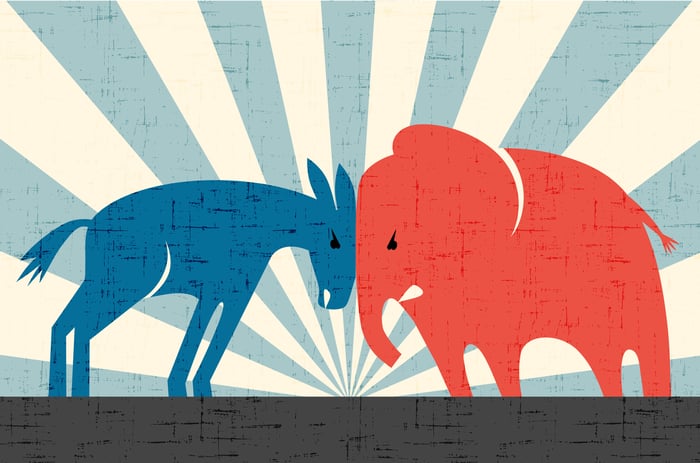It's truly amazing what a difference 23 years can make.
Back in 1995, not a single state in the U.S. nor either of its neighbors, Canada or Mexico, had legalized marijuana in any capacity. Within the U.S., the war on drugs was still in full swing, with a Gallup survey that year showing support for legalizing weed at a meager 25%.
Fast-forward to 2018, there are now far more states that have legalized medical cannabis than haven't in the United States, along with nine that have also given the green light to adult-use consumption. Meanwhile, Mexico legalized medical weed in June 2017, and to our north, Canada just passed the Cannabis Act on June 19, becoming the first industrialized nation in the world to legalize recreational pot. Legal sales to adults will officially kick off there on Oct. 17. And, as the icing on the cake, Gallup's Oct. 2017 poll found that an all-time high 64% of respondents favored the idea of legalizing marijuana. That's one heck of an about-face in just over two decades.

Image source: Getty Images.
This red state just became the 30th to approve medical weed in the U.S.
But don't think for a moment that this momentum is slowing down. With state primaries here, and the November elections right around the corner, a number of new cannabis legalizations could be on the docket. In fact, as a result of this past week's primaries, a new state is joining the ranks of having legalized medical cannabis.
Despite traditionally being a red state -- Republicans tend to have a mixed or negative view on marijuana, according to multiple polls – residents in Oklahoma overwhelmingly approved Question 788, with 891,654 votes cast, and 56.8% in favor of the measure to legalize medical marijuana. With this vote, Oklahoma becomes the 30th state to have passed broad-sweeping medical marijuana legalization, although 16 additional states allow cannabidiol (CBD) to be used for select medical purposes. Only four states completely ban all recreational and medical uses for cannabis and cannabinoids.
According to the proposal, eligible medical marijuana patients will be given licenses that are good for two years. Medical cannabis license holders will be allowed to possess up to eight ounces of cannabis, six mature plants, and six seedlings, as well as edibles and other concentrated forms of the drug, as noted by CBS News.

Image source: Getty Images.
However, what's really noteworthy about Oklahoma's proposal is that it doesn't provide a list of qualifying ailments. This is a fancy way of saying that physicians would have complete decision-making power in prescribing medicinal cannabis to a patient if he or she believes it would help that patient with whatever ailment(s) they have. That's markedly different from nearly every other legal medical cannabis state, which lists the specific ailments where weed can be prescribed by a physician.
Opponents of the measure remain concerned that the scope of the proposal is too broad, and that it could therefore lead to recreational use of the drug.
Real reform may be on the horizon
With residents in Utah and Michigan also set to vote on respective measures to green-light medical and recreational pot use, 2018 is on track to be another banner year for the legal cannabis movement. But even more than that, it could be the year that finally tips the scales toward reform -- at least on the medical side of the equation.
When examined broadly, the American public strongly favors the idea of legalization, as noted from Gallup's 2017 survey. But when analyzed by party, the GOP tends to have mixed feelings. In Gallup's survey, 51% of self-identified Republicans favored legalization. Meanwhile, an April survey from the independent Quinnipiac University found that just 41% of self-identified Republicans were in favor of broad-based legalization, compared to 55% who opposed the idea.

Image source: Getty Images.
But one area where there is strong consensus, even across party lines, is with regard to legalizing medical marijuana. Quinnipiac's poll shows 93% support for allowing physicians to prescribe cannabis to patients across all party lines, with 86% of self-identified members of the GOP in support of the idea. With favorability this high, it's not out of the question that the push to reschedule medical weed could gain traction on Capitol Hill.
In addition, the Food and Drug Administration did something on Monday, June 25, that's never been done before: It legalized a cannabis-derived compound. GW Pharmaceuticals' (GWPH) CBD-based oral drug known as Epidiolex dazzled in multiple phase 3 trials for patients with two rare types of childhood-onset epilepsy, Dravet syndrome and Lennox-Gastaut syndrome. In studies, Epidiolex led to a statistically significant reduction in seizure frequency relative to baseline, as well as when compared to a placebo. It's also the first drug ever approved to treat Dravet syndrome.
While investors might be focused on the $1 billion-plus in sales GW Pharmaceuticals could generate annually from its lead drug, assuming label expansion opportunities down the road, it's actually the approval of a cannabis-derived drug that bears more weight for the marijuana movement. Since marijuana's federal classification as a Schedule I drug means it's entirely illegal, prone to abuse, and has no recognized medical benefits, this decision by the FDA to approved GW Pharmaceuticals' Epidiolex is in direct conflict with that definition. In essence, its approval means it has medical benefits, which could coerce lawmakers to go back to the drawing board on cannabis.
In other words, the table is set for federal medical cannabis reform, but it's far from a guarantee with Republicans in control of the legislative branch of the government.




